
The Tohono Oʼodham are a Native American people of the Sonoran Desert, residing primarily in the U.S. state of Arizona and the northern Mexican state of Sonora. The United States federally recognized tribe is the Tohono Oʼodham Nation.

The Pascua Yaqui Tribe of Arizona is a federally recognized tribe of Yaqui Native Americans in the state of Arizona.
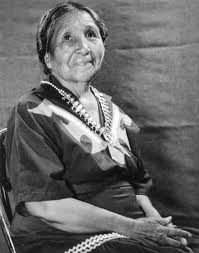
Viola Jimulla was the Chief of the Prescott Yavapai tribe. She became Chief when her husband, who was also a Chief of the tribe, died in an accident in 1940. She remained Chief until her death. She was known for improving living conditions, and for her work with the Presbyterian Church.

The Salt River Pima–Maricopa Indian Community (SRPMIC) comprises two distinct Native American tribes—the Pima and the Maricopa —many of whom were originally part of the Halchidhoma (Xalchidom) tribe. The community was permanently created by an Executive Order of US President Rutherford B. Hayes on June 14th, 1879. The community area includes 53,600 acres (217 km2), of which 19,000 remain a natural preserve. As of 2022, the total population is 7,386. The community is a federally recognized tribe located in Arizona.
Ofelia Zepeda is a Tohono O'odham poet and intellectual. She is Regents' Professor of Tohono O'odham language and linguistics and Director of the American Indian Language Development Institute (AILDI) at The University of Arizona. Zepeda is the editor for Sun Tracks, a series of books that focuses on the work of Native American artists and writers, published by the University of Arizona Press.
For the American educational theorist and educator, see Janet Hale.
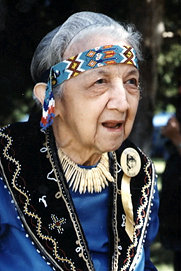
Gladys Iola Tantaquidgeon was a Mohegan medicine woman, anthropologist, author, tribal council member, and elder based in Connecticut.
"Big Chief" Russell Moore was an American jazz trombonist. Moore, a Pima tribe member, grew up on a Native American reservation before moving to Chicago and then Los Angeles where he learned to play various instruments, eventually settling on trombone. Throughout his career, Moore worked with an array of artists including Frank Sinatra, Lionel Hampton, Alberta Hunter and Pee Wee Russell as well as recording under his own name. He is best remembered for his work as a member of Louis Armstrong's band.
Anna Prieto Sandoval was an American leader of the Sycuan Band of the Kumeyaay Nation of southern California and a Native American gaming enterprises pioneer. She is credited with lifting the Sycuan Band reservation, which was plagued by poverty and substandard housing, to self-sufficiency by pioneering casino gambling on the reservation.
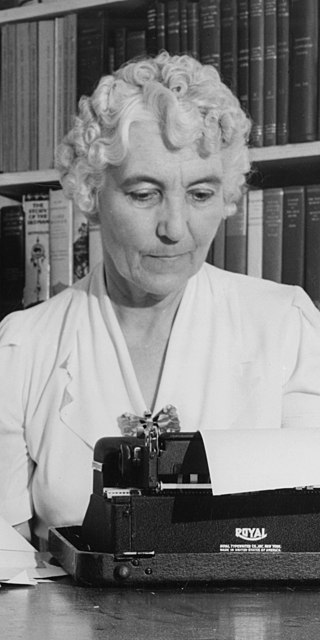
Ruth Murray Underhill was an American anthropologist. She was born in Ossining-on-the-Hudson, New York, and attended Vassar College, graduating in 1905 with a degree in Language and Literature. In 1907, she graduated from the London School of Economics and began travelling throughout Europe. During World War I, she worked for an Italian orphanage run by the Red Cross.
Mary V. Thomas was an American Pima politician and activist. Thomas was the first woman to serve as the Governor of the Gila River Indian Community, an office she held from 1994 to 2000. She also served as Lieutenant Governor of Gila River Indian Community for two tenures: The first term from 1990 to 1994, prior to becoming governor, and a second term beginning in 2003. An active participant in tribal politics, Thomas was also an activist on issues of importance to Native American communities, including poverty, water rights, and casinos.
Lucretia Breazeale Hamilton (1908–1986) was an American botanical illustrator, who was considered an expert on southwestern United States flora. She illustrated numerous technical papers for the University of Arizona and 16 books. She was posthumously recognized with a Desert Willow cultivar named in her honor and induction into the Arizona Women's Hall of Fame.

Ida Redbird was a Native American potter from the Gila River Indian Community of the Gila River Indian Reservation in Arizona. She was the first president of the Maricopa Pottery Maker's Association and was widely credited with the revival of ancient Maricopa pottery techniques and forms. Her polished black-on-redware pottery was highly prized with collectors. Texas photographer Ted Sayles shot a series documenting Redbird sculpting her pottery. The series toured museums throughout the Western United States

Sacate is a populated place in the Middle Gila River Valley area, within Pinal County, Arizona, United States. Located 8 mi (13 km) north of Maricopa on the south side of the Gila River near Pima Butte, Sacate was an Pima village, a railroad station of the Southern Pacific Railroad, and a Catholic mission. It had originally been called Sacaton Station but the name was shortened to its current version in 1904.

Mary V. Riley was an Apache tribal council member who was instrumental in the economic development of the White Mountain Apache Tribe. She was the first woman to be elected to serve on the tribal council and worked toward bringing timber and tourism industries to the reservation to ensure their economic stability. She was inducted into the Arizona Women's Hall of Fame posthumously in 1988.

Polingaysi Qöyawayma, also known as Elizabeth Q. White, was a Hopi educator, writer, and potter.
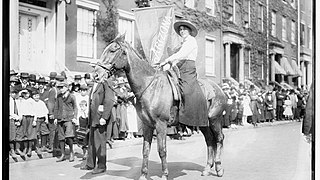
The movement for women's suffrage in Arizona began in the late 1800s. After women's suffrage was narrowly voted down at the 1891 Arizona Constitutional Convention, prominent suffragettes such as Josephine Brawley Hughes and Laura M. Johns formed the Arizona Suffrage Association and began touring the state campaigning for women's right to vote. Momentum built throughout the decade, and after a strenuous campaign in 1903, a woman's suffrage bill passed both houses of the legislature but was ultimately vetoed by Governor Alexander Oswald Brodie.

Ella Jean Hill Chaudhuri was an American community leader, activist, and author. She was a member of the Muscogee (Creek) Nation, executive director of the Tucson Indian Center, and director of the Traditional Indian Alliance. She was inducted into the Arizona Women's Hall of Fame posthumously, in 2013.
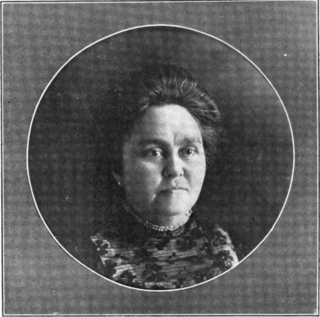
Rosa Meador Goodrich Boido was an American physician, suffragist, and temperance worker. She was the first woman to hold a medical license in Arizona.

Tucson Indian school was founded in 1888 with the purpose of facilitating the assimilation of native children of the Pima and Papago tribes from the area around what is now Tucson, Arizona. The school was created under federal acts with the goal of indoctrinating native American children into western colonial society by separating them from their communities' culture and reeducating them in boarding schools. The school closed in the 1950s.














